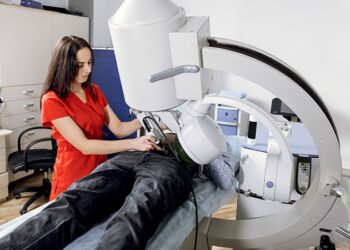The author of this article is an employee of Eli Lilly and Company.
Every 65 seconds, someone in the U.S. develops Alzheimer’s disease.1,2 More than 6 million Americans over age 65 are living with it today; it’s the fifth leading cause of death in the U.S. among individuals age 65 and older; and by 2060, up to 14 million Americans may have it.1,2
This projected increase in prevalence should not frighten but instead motivate us to reevaluate the way we think about, talk about, diagnose, and treat Alzheimer’s disease. This reevaluation is an opportunity that we cannot afford to miss.
There are now amyloid-targeting therapies on the market that have been approved for patients in the early symptomatic, mild cognitive impairment (MCI) or mild dementia stages of Alzheimer’s disease to help slow cognitive and functional decline. But these therapies have been shown to be most effective when administered as early as possible after symptoms present, so it is critical that patients obtain a timely and accurate diagnosis.3,4 This leaves time for a treatment plan to be activated — with the goal of slowing the progressive decline that may diminish people’s ability to remember new information, important dates, and appointments; plan and organize; make meals; use household appliances; manage finances; and be left alone.
Barriers to Timely Detection and Diagnosis of Alzheimer’s Disease
While the therapies available to patients to help slow cognitive and functional decline are likely to be most effective when initiated in the early stages of the disease once symptoms are detected, significant gaps remain in the timely and accurate diagnosis of Alzheimer’s disease for several key reasons.3,4
- Cognitive assessments have often been performed based on patient requests rather than healthcare professional proactivity. In 2022, the Alzheimer’s Association reported that 98% of primary care physicians do not conduct formal assessments of cognitive impairment unless requested by a patient or a loved one.2
- Although physicians tend to look to patients and their loved ones to identify and report any symptoms, those associated with Alzheimer’s disease are often confused as signs of normal aging and may be dismissed.3
- Methods used to detect Alzheimer’s disease pathology typically include amyloid positron emission tomography (PET) scans or cerebrospinal fluid (CSF) testing, both of which can be inaccessible and invasive for patients, often leading to a delay in diagnosis.
- Alzheimer’s disease has also been historically underdiagnosed — in fact, more than half of patients with dementia may have never been formally diagnosed. Even once patients notice the early signs of cognitive decline, a diagnosis can take two years or longer, keeping patients from potential care options.5-7
- There are also stigmas and fears surrounding Alzheimer’s disease diagnosis. Prior to the recent FDA approved amyloid-targeting therapies, there were no options to slow cognitive and functional decline, which left patients with limited hope following a diagnosis.
New Innovations in Alzheimer’s Diagnostics Make It Less Invasive and More Accessible
Today, we live in a new era for Alzheimer’s diagnosis and treatment. Not only are amyloid-targeting treatments available, supporting the need for timely and accurate Alzheimer’s diagnosis, but new innovations in biomarker testing can help us confirm the pathology of Alzheimer’s disease in symptomatic patients in a less invasive and more accessible way.8 This includes the introduction of blood-based biomarker tests, in addition to amyloid PET imaging and CSF tests. When evaluating patients with cognitive impairment, healthcare professionals can use these tools to confirm the presence of Alzheimer’s disease pathology to potentially aid in a more rapid and accurate diagnosis.
Over the last year, there has been a rapid proliferation of blood testing options to aid in the diagnosis of Alzheimer’s disease and, while this is beneficial for patient access to less-invasive testing, the variability in these tests can leave physicians and patients confused about which tests to order and when. Many factors should be considered when evaluating or comparing the performance of different blood tests, including the available validation data, the size of the data set used for clinical validation, demographics and prevalence of the disease in the population used for validation, the reference standard to which the test is compared (e.g., amyloid PET imaging, CSF test, clinical diagnosis), and other factors that inform how a test might be used in a clinical setting.
We continue to make great strides in Alzheimer’s disease diagnostics as we work toward the potential for even more accessible and accurate biomarker testing to enable a timely and accurate diagnosis for patients.
What You Can Do for Your Patients
In order for healthcare professionals to effectively use these more accessible ways of identifying Alzheimer’s disease pathology to help aid in a diagnosis, there is a need for primary care providers to identify cognitive impairment and refer patients for next steps.
It’s critical to:
- Educate and initiate conversations with patients and their loved ones early about the signs and symptoms of mild cognitive impairment (MCI) and mild dementia due to Alzheimer’s disease.
- Consider high quality blood-based biomarker testing for those with cognitive impairment who meet the testing criteria, following initial evaluations to aid in making a diagnosis or referral decision.
Visit Time is Hiding Something | Alzheimer’s Disease (lilly.com) to learn more about making a timely and accurate diagnosis in Alzheimer’s disease.
Anthony “Nino” Sireci, MD, MSc, is Head of Diagnostics Development & Commercialization at Eli Lilly and Company.
References
- Grabher BJ. Effects of Alzheimer’s disease on patients and their family. J Nucl Med Technol. 2018;46(4):335-340.
- Alzheimer’s Association. 2022 Alzheimer’s disease facts and figures. Alzheimers Dement. 2022;18(4):700-789.
- Porsteinsson AP, Isaacson RS, Knox S, et al. Diagnosis of early Alzheimer’s disease: clinical practice in 2021. J Prev Alzheimers Dis. 2021;3(8):371-386.
- Galvin JE, Aisen P, Langbaum JB, et al. Early stages of Alzheimer’s disease: evolving the care team for optimal patient management. Front Neurol. 2021;11:592302. doi: 10.3389/fneur.2020.592302.
- Lang K, Clifford A, Wei L, et al. Prevalence and determinants of undetected dementia in the community: a systematic literature review and a meta-analysis. BMJ Open. 2017;7(2):e011146. doi:10.1136/bmjopen-2016-011146.
- Boustani M, Peterson B, Hanson L, et al. U.S. Preventive Services Task Force. Screening for dementia in primary care: a summary of the evidence for the U.S. Preventive Services Task Force. Ann Intern Med. 2003;138(11):927-937.
- Blendon RJ, Benson JM, Wikler EM, et al. The impact of experience with a family member with Alzheimer’s disease on views about the disease across five countries. Int J Alzheimers Dis. 2012;2012:903645. doi:10.1155/2012/903645.
- SNMMI. Available at: https://www.snmmi.org/NewsPublications/NewsDetail.aspx?ItemNumber=42942 6 January 2023 [Accessed 15 November 2023].
- Hampel H, O’Bryant SE, Molinuevo JL, et al. Blood-based biomarkers for Alzheimer’s disease: mapping the road to the clinic. Nat Rev Neurol. 2018;14(11):639-652.
- Aisen PS, Cummings J, Jack CR Jr, et al. On the path to 2025: understanding the Alzheimer’s disease continuum. Alzheimers Res Ther. 2017;9(1):60.
The MedPage Today Editorial team was not involved in the creation of this content.
Source link : https://www.medpagetoday.com/ad-insights/industry-clinic/113412
Author :
Publish date : 2024-12-19 17:00:00
Copyright for syndicated content belongs to the linked Source.














